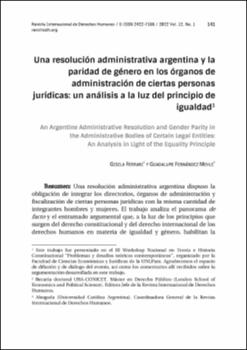| dc.contributor.author | Ferrari, Gisela | |
| dc.contributor.author | Fernández Mehle, Guadalupe | |
| dc.date.accessioned | 2022-12-06T15:10:46Z | |
| dc.date.available | 2022-12-06T15:10:46Z | |
| dc.date.issued | 2021-12 | |
| dc.identifier.issn | 2422-7188 | |
| dc.identifier.uri | https://riu.austral.edu.ar/handle/123456789/2004 | |
| dc.description.abstract | Una resolución administrativa argentina dispuso la obligación de integrar los directorios, órganos de administración y fiscalización de ciertas personas jurídicas con la misma cantidad de integrantes hombres y mujeres. El trabajo analiza el panorama de facto y el entramado argumental que, a la luz de los principios que surgen del derecho constitucional y del derecho internacional de los derechos humanos en materia de igualdad y género, habilitan la validez de la resolución. A tal fin, primero repasa los antecedentes judiciales y legislativos tendientes a cuestionar esa validez. Luego, analiza la resolución desde el punto de vista sustancial (contenido de la medida) y formal (competencia para emitirla de la autoridad correspondiente). Para este análisis, propone un esquema interpretativo que aborde la cuestión a partir del concepto de “igualdad como no sometimiento”, a través del cual los derechos constitucionales —como el derecho a asociarse libremente y la libertad de contratar— no implican únicamente un límite para el accionar del Estado, sino también una obligación positiva de asegurar su ejercicio e impedir que las preconcepciones de los particulares interfieran con la autonomía personal de sus pares. Al aplicar este esquema a la medida, resulta que no solo es válida, sino que además cumple con las obligaciones internacionales asumidas por el Estado argentino en materia de igualdad. | es |
| dc.description.abstract | An Argentine administrative resolution established the obligation to integrate the boards of directors, administrative and control bodies of certain legal entities with the same number of male and female members. This paper analyzes the argumentative framework that, considering theprinciples that arise from constitutional law and international human rights law on equality and gender, enable the validity of the resolution. To this end, it first reviews the judicial and legislative measures that have questioned that validity. Then, it analyzes the resolution both from a substantial and a formal point of view. For this analysis, it proposes an interpretative scheme that addresses the issue from the concept of “equality as non-submission”, through which constitutional rights–such as freedom of association and freedom of contract–do not only imply a limit for State actions, but also a positive obligation to ensure their exercise and prevent the preconceptions of individuals from interfering with the personal autonomy of their peers. By applying this scheme to the measure, it turns out that it is not only valid, but that it also complies with the international obligations assumed by the
Argentine State in matters of equality. | es |
| dc.language.iso | es | es |
| dc.publisher | Centro Latinoamericano de Derechos Humanos y Universidad Austral. | es |
| dc.relation.ispartofseries | Vol. 12, no. 1, 2022; | |
| dc.rights | Attribution-NonCommercial-NoDerivatives 4.0 Internacional | * |
| dc.rights.uri | http://creativecommons.org/licenses/by-nc-nd/4.0/ | * |
| dc.subject | Principio de igualdad | es |
| dc.subject | Paridad de género | es |
| dc.subject | Interpretación constitucional | es |
| dc.title | Una resolución administrativa argentina y la paridad de género en los órganos de administración de ciertas personas jurídicas: un análisis a la luz del principio de igualdad | es |
| dc.title.alternative | An Argentine Administrative Resolution and Gender Parity in the Administrative Bodies of Certain Legal Entities:An Analysis in Light of the Equality Principle | es |
| dc.type | Article | es |


